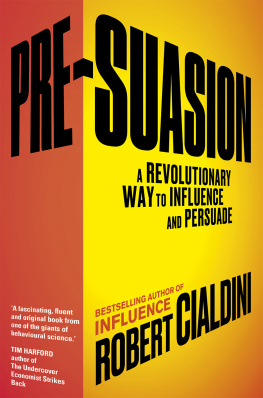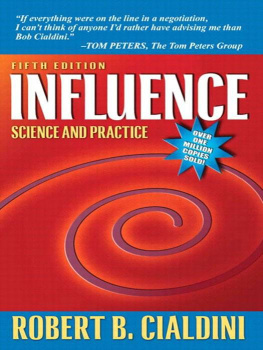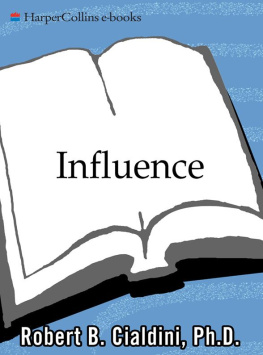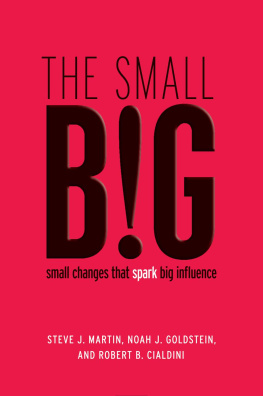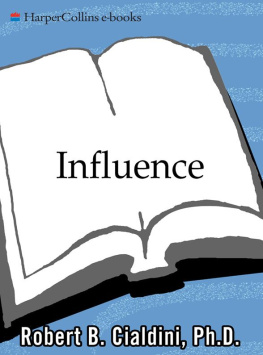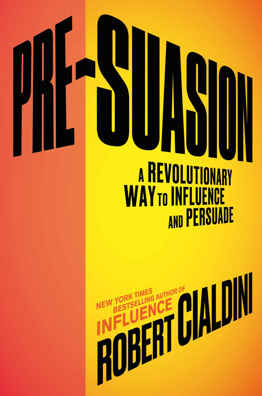Contents
Guide
For Hailey, who, every time I see her, leaves me more amazed.
For Dawson, who, every time I see him, leaves me
more convinced he will do great things.
For Leia, who, every time I see her, leaves me a happier man.
Contents
From the outset, Influence was designed for the popular reader, and as such, an attempt was made to write it in a nonacademic, conversational style. I admit to doing so with some trepidation that the book would be viewed as a form of pop psychology by my academic colleagues. I was concerned because, as the legal scholar James Boyle observed, You have never heard true condescension until you have heard academics pronounce the word popularizer. For this reason, at the time of the first writing of Influence, most of my fellow social psychologists didnt feel safe, professionally, writing for a nonacademic audience. Indeed, if social psychology had been a business, it would have been known for having great research and development units but no shipping department. We didnt ship, except to one another in academic journal articles that no one else was likely to encounter, let alone use.
Fortunately, although I decided to push ahead with a popular style, none of my fears has been realized, as Influence has not received disparagement on pop psychology grounds. Consequently, in subsequent versions, including the present one, the conversational style is retained. Of course, more importantly, I also present the research evidence for my statements, recommendations, and conclusions. Although the conclusions of Influence are illuminated and corroborated through such devices as interviews, quotes, and systematic personal observations, those conclusions are invariably based on properly conducted psychological research.
Comment on This Edition of Influence
Shaping the current edition of Influence has been challenging for me. On the one hand, recalling the Dont fix whats not broken axiom, I was reluctant to perform major reconstructive surgery. After all, previous versions had sold more copies than I could have sensibly imagined, in multiple editions and forty-four languages. In this last regard, my Polish colleague, Professor Wilhelmina Wosinska, offered an affirming (yet sobering) commentary on the perceived worth of the book. She said, You know, Robert, your book Influence is so famous in Poland, my students think youre dead.
On the other hand, in keeping with a quote my Sicilian grandfather favored, If you want things to stay as they are, things will have to change, there was a case to be made for timely upgrades. It has been some time since Influence was last published, and, in the interim, changes have occurred that deserve a place in this new edition. First, we now know more than we did before about the influence process. The study of persuasion, compliance, and change has advanced, and the pages that follow have been adapted to reflect that progress. In addition to an overall update of the material, I have devoted more attention to updated coverage of the role of influence in everyday human interactionhow the influence process works in real-world settings rather than in laboratory contexts.
Relatedly, I have also expanded a feature that was stimulated by the responses of prior readers. This feature highlights the experiences of individuals who have read Influence, recognized how one of the principles worked on (or for) them in a particular instance, and wrote to me describing the event. Their descriptions, which appear in the Readers Reports of each chapter, illustrate how easily and frequently we can fall victim to the influence process in our daily lives. There are now many new firsthand accounts of how the books principles apply to commonplace professional and personal situations. I wish to thank the following individuals whoeither directly or through their course instructorscontributed the Readers Reports used in past editions: Pat Bobbs, Hartnut Bock, Annie Carto, Michael Conroy, William Cooper, Alicia Friedman, William Graziano, Jonathan Harries, Mark Hastings, Endayehu Kendie, Karen Klawer, Danuta Lubnicka, James Michaels, Steven Moysey, Katie Mueller, Paul Nail, Dan Norris, Sam Omar, Alan J. Resnik, Daryl Retzlaff, Geofrey Rosenberger, Joanna Spychala, Robert Stauth, Dan Swift, and Karla Vasks. Special thanks are due to those who provided new Readers Reports for this edition: Laura Clark, Jake Epps, Juan Gomez, Phillip Johnston, Paola, Joe St. John, Carol Thomas, Jens Trabolt, Lucas Weimann, Anna Wroblewski, and Agrima Yadav. I would also like to invite readers to contribute similar reports for possible publication in a future edition. They can be sent to me at ReadersReports@InfluenceAtWork.com. Finally, more influence-relevant information can be obtained at www.InfluenceAtWork.com.
Besides the changes in this edition that are updated extensions of previously existing features of the book, three elements appear for the first time. One explores internet-based applications of proven social-influence tactics. It is clear that social media and e-commerce sites have embraced the lessons of persuasion science. Accordingly, each chapter now includes, in specially created eBoxes, illustrations of how this migration into current technologies has been accomplished. The second novel feature is the enhanced use of endnotes as the place where readers can find citations for the research described in the text as well citations and descriptions of related work. The endnotes now allow for a more inclusive, narrative account of the issues at hand. Finally, and most significantly, I have added a seventh universal principle of social influence to the bookthe principle of unity. In the chapter devoted to unity, I describe how individuals who can be convinced that a communicator shares a meaningful personal or social identity with them become remarkably more susceptible to the communicators persuasive appeals.
I can admit it freely now. All my life Ive been a patsy. For as long as I can recall, Ive been an easy mark for the pitches of peddlers, fundraisers, and operators of one sort or another. True, only some have had dishonorable motives. The othersrepresentatives of certain charitable agencies, for instancehave had the best intentions. No matter. With personally disquieting frequency, I have always found myself in possession of unwanted magazine subscriptions or tickets to the sanitation workers ball. Probably this long-standing status as sucker accounts for my interest in the study of compliance: Just what are the factors that cause one person to say yes to another? And which techniques most effectively use these factors to bring about compliance? I have wondered why it is that a request stated in a certain way will be rejected, but a request asking for the same favor in a slightly different fashion will be successful.
So in my role as an experimental social psychologist, I began to research the psychology of compliance. At first the research took the form of experiments performed, for the most part, in my laboratory and on college students. I wanted to find out which psychological principles influenced the tendency to comply with a request. Right now, psychologists know quite a bit about these principleswhat they are and how they work. I have characterized such principles as levers of influence and will be discussing some of the most important in this book.
After a time, though, I began to realize that the experimental work, while necessary, wasnt enough. It didnt allow me to judge the importance of the principles in the world beyond the psychology building and the campus where I was examining them. It became clear that if I were to understand fully the psychology of compliance, I would need to broaden my scope of investigation. I would need to look to the compliance professionalsthe people who had been using the principles on me all my life. They know what works and what doesnt; the law of survival of the fittest assures it. Their business is to make us comply, and their livelihoods depend on it. Those who dont know how to get people to say yes soon fall away; those who do, stay and flourish.


